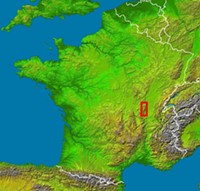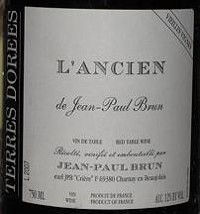Dave Nelson is the author of the blog Beer, Wine and Whisky. He writes about wine for Gut Check every Tuesday.
As time will show, I'm a pretty diverse drinker -- but that doesn't mean I don't have my favorites. I thought sharing one of these would be a nice introduction to my new wine column, the Noble Writ.
Wine, for me, is primarily about being a good companion to food. Ideally, a wine will improve a dish; at worst, it won't get in the way. On occasion, I do have a glass or two of wine without food, but odds are it's a white. So while my go-to red should have the complexity to be enjoyed alone, its main characteristic must be great flexibility at the table.
Looking at my personal consumption history over the past several years -- yes, I am geeky enough to track this -- three wines jump out as contenders for the title of my go-to red. All three happen to made from the same grape variety, gamay -- or, if we're going to be formal, gamay noir à jus blanc. Gamay is relatively low in tannin, but quite high in acid. This combination makes good gamay a juicy wine that can cut through fat and richness as well as cleanse and refresh the palate.
My choice as go-to red is the Beaujolais L'Ancien made by Jean-Paul Brun at the Domaine Terres-Dorées. The Beaujolais is a vast and prolific region just South of Burgundy, and is best known to most people as the source of Beaujolais Nouveau, that quickly fermented and released mainstay of "what wine to have with Thanksgiving dinner?" columns. (Brun makes a benchmark Nouveau by the way.)
The Beaujolais produces, quite frankly, a lot of what the French call plonk (though it is expensive for plonk): innocuous, soulless liquid whose primary selling point is that it contains alcohol. There are exceptions in ten villages, collectively referred to as the "Crus" (more about them in future posts), which are recognized for their higher quality wines, but Brun's l'Ancien doesn't come from one of the Crus.
The quality of l'Ancien comes instead from M. Brun's commitment to a different way of making wine. He employs natural yeasts, little or no chaptalization (adding sugar to the grapes to, ahem, "extend the length of the fermentation" -- it just also happens to make a higher alcohol wine and allows the growers to raise a heavier crop), little added sulphur, and light to no filtration. The result is a finished wine that is modest in alcohol (usually around 11%) but that brings a lot of flavor.
Brun's l'Ancien is an underdog wine: The grape variety has a middling reputation, the region has a not too impressive pedigree, and there's no new oak and little tannin. It just happens to be a lithe, lively drink that complements just about everything you might want to eat with it, and it has enough flavor that drinking a glass or two in the backyard on a warm spring day makes an otherwise pleasant experience even better.
The current release of l'Ancien is the 2007. Due to a disagreement with the French wine bureaucracy neither the word "Beaujolais" nor the year "2007" are mentioned on the labels of two-thirds of the bottles (more on this dispute here and here).
Mine, which was not labeled "Beaujolais," poured a typical blue-tinted red, with aromas of somewhat ripe cherries mixed with floral notes. It was a bit richer on the palate than most vintages of l'Ancien, but the bright, zippy acidity keeps the fruit moving along. It remained delicious over the course of three days simply re-corked on the counter.
Brun's wines are imported by Louis Dressner Selections. I purchased my bottle for $17 at Bon Vivant Wines in Columbia, IL. For the record, all wines I review in this blog are purchased at retail or auction by me at normal prices, except as otherwise noted.
- Local St. Louis
- News
- Things to Do
- Arts & Culture
- Food & Drink
- Music
- Movies
- St. Louis in Pictures
- About Riverfront Times
- About Us
- Advertise
- Contact Us
- Jobs
- Support Riverfront Times
- Big Lou Holdings, LLC
- Cincinnati CityBeat
- Louisville Leo Weekly
- Detroit Metro Times
- St. Louis Riverfront Times
- Sauce Magazine




